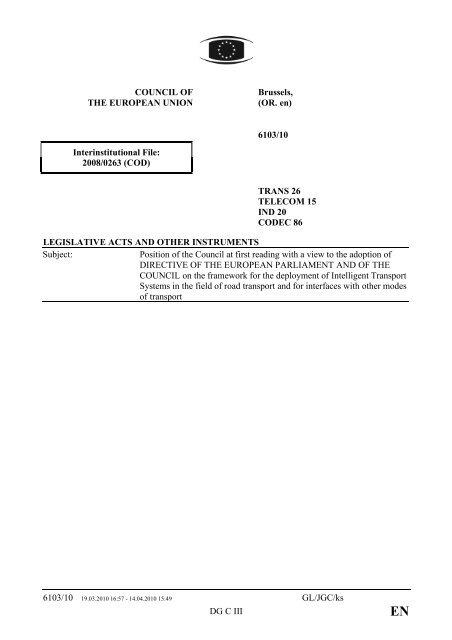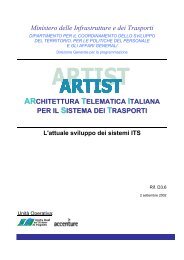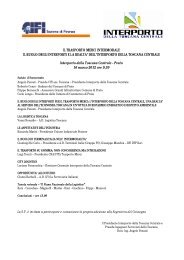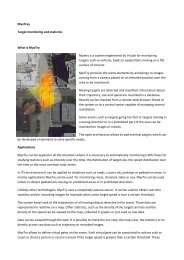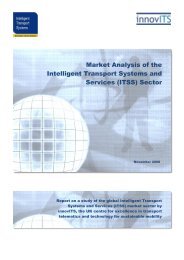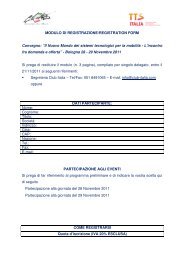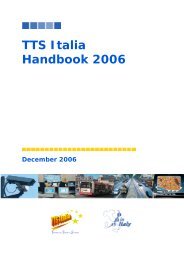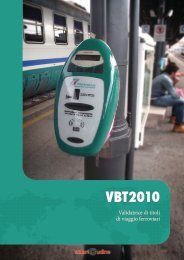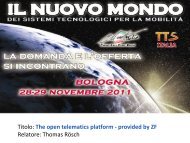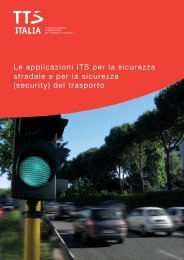6103/10 TRANS 26 TE - TTS Italia
6103/10 TRANS 26 TE - TTS Italia
6103/10 TRANS 26 TE - TTS Italia
Create successful ePaper yourself
Turn your PDF publications into a flip-book with our unique Google optimized e-Paper software.
COUNCIL OF<br />
THE EUROPEAN UNION<br />
Brussels,<br />
(OR. en)<br />
<strong>6<strong>10</strong>3</strong>/<strong>10</strong><br />
Interinstitutional File:<br />
2008/0<strong>26</strong>3 (COD)<br />
<strong>TRANS</strong> <strong>26</strong><br />
<strong>TE</strong>LECOM 15<br />
IND 20<br />
CODEC 86<br />
LEGISLATIVE ACTS AND OTHER INSTRUMENTS<br />
Subject:<br />
Position of the Council at first reading with a view to the adoption of<br />
DIRECTIVE OF THE EUROPEAN PARLIAMENT AND OF THE<br />
COUNCIL on the framework for the deployment of Intelligent Transport<br />
Systems in the field of road transport and for interfaces with other modes<br />
of transport<br />
<strong>6<strong>10</strong>3</strong>/<strong>10</strong> 19.03.20<strong>10</strong> 16:57 - 14.04.20<strong>10</strong> 15:49 GL/JGC/ks<br />
DG C III<br />
EN
DIRECTIVE 20<strong>10</strong>/…/EU<br />
OF THE EUROPEAN PARLIAMENT AND OF THE COUNCIL<br />
of<br />
on the framework for the deployment<br />
of Intelligent Transport Systems in the field of road transport<br />
and for interfaces with other modes of transport<br />
THE EUROPEAN PARLIAMENT AND THE COUNCIL OF THE EUROPEAN UNION,<br />
Having regard to the Treaty on the Functioning of the European Union, and in particular Article 91<br />
thereof,<br />
Having regard to the proposal from the European Commission,<br />
Having regard to the opinion of the European Economic and Social Committee 1 ,<br />
Having regard to the opinion of the Committee of the Regions 2 ,<br />
Acting in accordance with the ordinary legislative procedure 3 ,<br />
3<br />
1<br />
2<br />
OJ C 277, 17.11.2009, p. 85.<br />
OJ C , , p. .<br />
Position of the European Parliament of 23 April 2009 (not yet published in the Official<br />
Journal), position of the Council of ... (not yet published in the Official Journal), position of the European<br />
Parliament of ... (not yet published in the Official Journal) (and decision of the Council of ... ).<br />
<strong>6<strong>10</strong>3</strong>/<strong>10</strong> 19.03.20<strong>10</strong> 16:57 - 14.04.20<strong>10</strong> 15:49 GL/JGC/ks 1<br />
DG C III<br />
EN
Whereas:<br />
(1) The increase in the volume of road transport in the Union associated with the growth of the<br />
European economy and mobility requirements of citizens is the primary cause of<br />
increasing congestion of road infrastructure and rising energy consumption, as well as a<br />
source of environmental and social problems.<br />
(2) Traditional measures such as, notably, the expansion of the existing road transport<br />
infrastructure are not a sufficient response to such major challenges. Innovation will have a<br />
major role to play in finding appropriate solutions for the Union.<br />
(3) Intelligent Transport Systems (ITS) are advanced applications which without embodying<br />
intelligence as such aim to provide innovative services relating to different modes of<br />
transport and traffic management and enable various user-groups to be better informed and<br />
make safer, more coordinated and "smarter" use of transport networks.<br />
<strong>6<strong>10</strong>3</strong>/<strong>10</strong> 19.03.20<strong>10</strong> 16:57 - 14.04.20<strong>10</strong> 15:49 GL/JGC/ks 2<br />
DG C III<br />
EN
(4) ITS integrate telecommunications, electronics and information technologies with transport<br />
engineering in order to plan, design, operate, maintain and manage transport systems. The<br />
application of information and communication technologies to the road transport sector<br />
and its interfaces with other modes of transport will make a significant contribution to<br />
improving environmental performance, efficiency, including energy efficiency, safety and<br />
security of road transport including the transport of dangerous goods, public security,<br />
passenger and freight mobility whilst at the same time ensuring the functioning of the<br />
internal market as well as increased levels of competitiveness and employment. ITS<br />
applications and services should be without prejudice to matters concerning national<br />
security or which are necessary in the interest of defence.<br />
(5) Advances in the field of the application of information and communication technologies to<br />
other modes of transport should now be reflected in developments in the road transport<br />
sector, in particular with a view to ensuring higher levels of integration between road<br />
transport and other modes of transport.<br />
(6) In some Member States national application of ITS technologies are already being<br />
deployed in the road transport sector. However, such deployment remains fragmented and<br />
uncoordinated and cannot provide geographical continuity of ITS services throughout the<br />
Union and at its external borders.<br />
<strong>6<strong>10</strong>3</strong>/<strong>10</strong> 19.03.20<strong>10</strong> 16:57 - 14.04.20<strong>10</strong> 15:49 GL/JGC/ks 3<br />
DG C III<br />
EN
(7) To ensure a coordinated and effective deployment of ITS within the Union as a whole,<br />
common specifications, including, where appropriate, standards, defining further detailed<br />
provisions and procedures should be introduced. Before adopting any specifications, the<br />
Commission should assess their compliance with certain defined principles set out in<br />
Annex II. When adopting specifications, priority should be given to the four main areas of<br />
ITS development and deployment. Within those four areas, priority actions should be<br />
established for the development and use of specifications and standards. During further<br />
implementation of ITS the existing ITS infrastructure deployed by a particular<br />
Member State should be taken into account in terms of technological progress and<br />
financial outlay.<br />
(8) When a legislative act is adopted in accordance with the second subparagraph of<br />
Article 6(2), of this Directive, the second sentence of Article 5(1) should be amended<br />
accordingly.<br />
(9) The common specifications should, inter alia take into account and build upon the<br />
experience and results already obtained in the field of ITS, notably in the context of the<br />
eSafety initiative, launched by the Commission in April 2002. The eSafety Forum was<br />
established by the Commission under that initiative to promote and further implement<br />
recommendations to support the development, deployment and use of eSafety systems.<br />
<strong>6<strong>10</strong>3</strong>/<strong>10</strong> 19.03.20<strong>10</strong> 16:57 - 14.04.20<strong>10</strong> 15:49 GL/JGC/ks 4<br />
DG C III<br />
EN
(<strong>10</strong>) Vehicles which are operated mainly for their historical interest and were originally<br />
registered and/or type-approved and/or put into service before the entry into force of this<br />
Directive and of its implementing measures should not be affected by the rules and<br />
procedures laid down in this Directive.<br />
(11) ITS should build on interoperable systems which are based on open and public standards<br />
and available on a non-discriminatory basis to all application and service suppliers<br />
and users.<br />
(12) The deployment and use of ITS applications and services will entail the processing of<br />
personal data. Such processing should be carried out in accordance with Union law, as set<br />
out, in particular, in Directive 95/46/EC of the European Parliament and of the Council<br />
of 24 October 1995 on the protection of individuals with regard to the processing of<br />
personal data and on the free movement of such data 1 and in Directive 2002/58/EC of the<br />
European Parliament and of the Council of 12 July 2002 concerning the processing of<br />
personal data and the protection of privacy in the electronic communications sector 2 . Inter<br />
alia, the principles of purpose limitation and data minimisation should be respected in the<br />
application of ITS.<br />
1<br />
2<br />
OJ L 281, 23.11.1995, p. 31.<br />
OJ L 201, 31.7.2003, p. 37.<br />
<strong>6<strong>10</strong>3</strong>/<strong>10</strong> 19.03.20<strong>10</strong> 16:57 - 14.04.20<strong>10</strong> 15:49 GL/JGC/ks 5<br />
DG C III<br />
EN
(13) Anonymisation of personal data should be encouraged as one of the principles of<br />
enhancing individuals' privacy. As far as data protection and privacy related issues in the<br />
field of ITS applications and services deployment are concerned, the Commission should,<br />
as appropriate, further consult the European Data Protection Supervisor and request an<br />
opinion of the Working Party on the Protection of Individuals with regard to the Processing<br />
of Personal Data established by Article 29 of Directive 95/46/EC.<br />
(14) The deployment and use of ITS applications and services, and notably traffic and travel<br />
information services, will entail the processing and use of road, traffic and travel data<br />
forming part of documents held by public sector bodies of the Member States. Such<br />
processing and use should be carried out in accordance with Directive2003/98/EC of the<br />
European Parliament and of the Council of 17 November 2003 on the re-use of public<br />
sector information 1 .<br />
1<br />
OJ L 345, 31.12.2003, p. 90.<br />
<strong>6<strong>10</strong>3</strong>/<strong>10</strong> 19.03.20<strong>10</strong> 16:57 - 14.04.20<strong>10</strong> 15:49 GL/JGC/ks 6<br />
DG C III<br />
EN
(15) In appropriate cases, the specifications should include detailed provisions laying down the<br />
procedure governing assessment of conformity or suitability for use of constituents. Those<br />
provisions should be based on Decision No 768/2008/EC of the European Parliament and<br />
of the Council of 9 July 2008 on a common framework for the marketing of products 1 , in<br />
particular concerning the modules for the various phases of the conformity assessment<br />
procedures. Directive 2007/46/EC 2 already establishes a framework for the type approval<br />
of motor vehicles and their parts or related equipment, and Directive 2002/24/EC 3 and<br />
Directive 2003/37/EC 4 lie down rules on the type approval of two or three-wheel motor<br />
vehicles, and agricultural or forestry tractors and their parts or related equipment.<br />
Therefore, it would be a duplication of work to provide for conformity assessment of<br />
equipment and applications falling within the scope of those Directives. At the same time,<br />
although those Directives apply to ITS-related equipment installed in vehicles, they do not<br />
apply to external road infrastructure ITS equipment and software. In such cases, the<br />
specifications could provide for conformity assessment procedures. Such procedures<br />
should be limited to what would be necessary in each separate case.<br />
1<br />
2<br />
3<br />
4<br />
OJ L 218, 13.08.2008, p. 82.<br />
OJ L <strong>26</strong>3, 09.<strong>10</strong>.2007, p. 1.<br />
OJ L 124, 09.05.2002, p. 1.<br />
OJ L 171, 09.07.2003, p. 1.<br />
<strong>6<strong>10</strong>3</strong>/<strong>10</strong> 19.03.20<strong>10</strong> 16:57 - 14.04.20<strong>10</strong> 15:49 GL/JGC/ks 7<br />
DG C III<br />
EN
(16) For ITS applications and services for which accurate and guaranteed timing and<br />
positioning services are required, satellite-based infrastructures or any technology<br />
providing an equivalent level of precisions should be used, such as those provided for in<br />
Council Regulation (EC) No 1/2005 of 22 December 2004 on the protection of animals<br />
during transport and related operations 1 and Regulation (EC) No 683/2008 of the European<br />
Parliament and of the Council of 9 July 2008 on the further implementation of the<br />
European satellite navigation programmes (EGNOS and Galileo) 2 .<br />
(17) Innovative technologies such as Radio Frequency Identification Devices (RFID), EGNOS<br />
or Galileo should be used for the realisation of ITS applications, notably for the tracking<br />
and tracing of freight along its journey and across modes of transport.<br />
1<br />
2<br />
OJ L 3, 5.1.2005, p. 1.<br />
OJ L 196, 24.7.2008, p. 1.<br />
<strong>6<strong>10</strong>3</strong>/<strong>10</strong> 19.03.20<strong>10</strong> 16:57 - 14.04.20<strong>10</strong> 15:49 GL/JGC/ks 8<br />
DG C III<br />
EN
(18) Major stakeholders such as ITS service providers, associations of ITS users, transport and<br />
facilities operators, representatives of the manufacturing industry, social partners,<br />
professional associations and local authorities should have the possibility to advise the<br />
Commission on the commercial and technical aspects of the deployment of ITS within the<br />
Union. For this purpose the Commission, ensuring close cooperation with stakeholders and<br />
Member States, should set up an ITS advisory group. The work of the advisory group<br />
should be carried out in a transparent manner and the result should be made available to the<br />
Committee established by this Directive.<br />
(19) Uniform conditions of implementation should be ensured for the adoption of guidelines and<br />
non-binding measures to facilitate Member's States cooperation in respect of ITS priority<br />
areas on ITS as well as to of guidelines for reporting by the Member States and to of a<br />
working programme. [grey: EN improvement, to be verified with DG. JLs: For source of<br />
translation see the comment below.]<br />
(20) According to Article 291 of the Treaty on the Functioning of the European Union,<br />
rules and general principles concerning mechanisms for the control by Member States of the<br />
Commission's exercise of its implementing powers shall be laid down in advance by a<br />
regulation adopted in accordance with the ordinary legislative procedure. Pending the<br />
adoption of that new regulation, the provisions of Council Decision 1999/468/EC of 28 June<br />
1999 laying down the procedures for the exercise of implementing powers conferred on the<br />
Commission 2 continues to apply, with the exception of the regulatory procedure with scrutiny,<br />
which is not applicable. [JLs: For inspiration on the translation use see recital (7) of doc.<br />
6314/<strong>10</strong> but be careful, since: a) there are minor, but important differences which I<br />
highlighted in yellow.; b) 6314/<strong>10</strong> is an EP translation which has not yet gone through JL<br />
revision.]<br />
(21) The Commission should be empowered to adopt delegated acts in accordance with Article<br />
290 of the Treaty in respect of the adoption of specifications. It is of particular importance<br />
that the Commission carry ies out appropriate consultations during its preparatory work,<br />
including at experts' level. [JLs: Please use the translation in recital (12) of PE-CONS 7/<strong>10</strong><br />
2<br />
OJ L 184, 17.7.1999, p. 23.<br />
<strong>6<strong>10</strong>3</strong>/<strong>10</strong> 19.03.20<strong>10</strong> 16:57 - 14.04.20<strong>10</strong> 15:49 GL/JGC/ks 9<br />
DG C III<br />
EN
and align your revised versions because we should have identical versions in the different<br />
documents for these sensitive sections.<br />
<strong>6<strong>10</strong>3</strong>/<strong>10</strong> 19.03.20<strong>10</strong> 16:57 - 14.04.20<strong>10</strong> 15:49 GL/JGC/ks <strong>10</strong><br />
DG C III<br />
EN
(22) In order to guarantee a coordinated approach, the Commission should ensure coherence<br />
between the activities of the Committee established by this Directive and those of the<br />
Committee established by Directive 2004/52/EC of the European Parliament and of the<br />
Council of 29 April 2004 on the interoperability of electronic road toll systems in the<br />
Community 1 , the Committee established by Council Regulation (EEC) No 3821/85 on<br />
recording equipment in road transport 2 , the Committee established by Directive<br />
2007/46/EC and the Committee established by Directive 2007/2/EC of the European<br />
Parliament and of the Council of 14 March 2007 establishing an Infrastructure for Spatial<br />
Information in the European Community (INSPIRE) 3 .<br />
1<br />
2<br />
3<br />
OJ L 166, 30.04.2004, p. 124.<br />
OJ L 370, 31.12.1985, p. 8.<br />
OJ L <strong>10</strong>8, 25.4.2007, p. 1.<br />
<strong>6<strong>10</strong>3</strong>/<strong>10</strong> 19.03.20<strong>10</strong> 16:57 - 14.04.20<strong>10</strong> 15:49 GL/JGC/ks 11<br />
DG C III<br />
EN
(23) Since the objective of this Directive, namely to ensure the coordinated and coherent<br />
deployment and use of interoperable Intelligent Transport Systems throughout the Union<br />
cannot be sufficiently achieved by the Member States and/or the private sector and can<br />
therefore, by reason of its scale and effects, be better achieved at Union level, the Union<br />
may adopt measures, in accordance with the principle of subsidiarity as set out in Article 5<br />
of the Treaty on European Union. In accordance with the principle of proportionality as set<br />
out in that Article, this Directive does not go beyond what is necessary in order to achieve<br />
that objective.<br />
(24) In accordance with point 34 of the Interinstitutional Agreement on better law-making,<br />
Member States are encouraged to draw up, for themselves and in the interest of the Union,<br />
their own tables, which will, as far as possible, illustrate the correlation between this<br />
Directive and the transposition measures, and to make them public,<br />
HAVE ADOP<strong>TE</strong>D THIS DIRECTIVE:<br />
<strong>6<strong>10</strong>3</strong>/<strong>10</strong> 19.03.20<strong>10</strong> 16:57 - 14.04.20<strong>10</strong> 15:49 GL/JGC/ks 12<br />
DG C III<br />
EN
Article 1<br />
Subject matter and scope<br />
1. This Directive establishes a framework in support of the coordinated and coherent<br />
deployment and use of Intelligent Transport Systems (ITS) within the Union, in particular<br />
across the borders between the Member States, and sets out the general conditions<br />
necessary for that purpose.<br />
2. This Directive provides for the development of specifications for actions within the priority<br />
areas referred to in Article 2, as well as for the development, where appropriate, of<br />
necessary standards.<br />
3. This Directive shall apply to ITS applications and services in the field of road transport and<br />
to their interfaces with other modes of transport without prejudice to matters concerning<br />
national security or necessary in the interest of defence.<br />
Article 2<br />
Priority areas<br />
1. For the purpose of this Directive the following shall constitute priority areas for the<br />
development and use of specifications and standards:<br />
– I. Optimal use of road, traffic and travel data;<br />
<strong>6<strong>10</strong>3</strong>/<strong>10</strong> 19.03.20<strong>10</strong> 16:57 - 14.04.20<strong>10</strong> 15:49 GL/JGC/ks 13<br />
DG C III<br />
EN
– II. Continuity of traffic and freight management ITS services;<br />
– III. ITS road safety and security applications;<br />
– IV. Linking the vehicle with the transport infrastructure.<br />
2. The nature and content of the priority areas is specified in Annex I.<br />
Article 3<br />
Priority actions<br />
The following shall constitute priority actions within the relevant priority areas for the development<br />
and use of specifications and standards, as set out in Annex I:<br />
(a)<br />
(b)<br />
(c)<br />
(d)<br />
the provision of EU-wide multimodal travel information services;<br />
the provision of EU-wide real-time traffic information services;<br />
data and procedures for the provision, where possible, of road safety related minimum<br />
universal traffic information free of charge to users;<br />
the harmonised provision for an interoperable EU-wide eCall;<br />
<strong>6<strong>10</strong>3</strong>/<strong>10</strong> 19.03.20<strong>10</strong> 16:57 - 14.04.20<strong>10</strong> 15:49 GL/JGC/ks 14<br />
DG C III<br />
EN
(e)<br />
(f)<br />
the provision of information services for safe and secure parking places for trucks and<br />
commercial vehicles;<br />
the provision of reservation services for safe and secure parking places for trucks and<br />
commercial vehicles.<br />
Article 4<br />
Definitions<br />
For the purposes of this Directive, the following definitions shall apply:<br />
1. "Intelligent Transport Systems" or "ITS" means systems in the field of road transport<br />
(including infrastructure, vehicles and users), in which information and communication<br />
technologies are applied, traffic management and mobility management, as well as the<br />
interfaces to other modes of transport;<br />
2. "interoperability" means the capacity of systems and the underlying business processes, to<br />
exchange data and to share information and knowledge;<br />
3. "ITS application" means an operational instrument for the application of ITS;<br />
4. "ITS service" means the provision of an ITS application through a well-defined<br />
organisational and operational framework with the aim of contributing to user safety,<br />
efficiency, comfort and/or to facilitate or support transport and travel operations;<br />
<strong>6<strong>10</strong>3</strong>/<strong>10</strong> 19.03.20<strong>10</strong> 16:57 - 14.04.20<strong>10</strong> 15:49 GL/JGC/ks 15<br />
DG C III<br />
EN
5. "ITS service provider" means any provider of an ITS service, whether public or private;<br />
6. "ITS user" means any user of ITS applications or services including travellers, vulnerable<br />
road users, road transport infrastructure users and operators, fleet managers and operators<br />
of emergency services;<br />
7. "Vulnerable road users" means non-motorised road users, such as pedestrians and cyclists<br />
as well as motor-cyclists and persons with disabilities or reduced mobility and orientation;<br />
8. "nomadic device" means a portable communication or information device that can be<br />
brought inside the vehicle to support the driving task and/or the transport operations;<br />
9. "platform" means an on-board or off-board unit enabling the deployment, provision,<br />
exploitation and integration of ITS applications and services;<br />
<strong>10</strong>. "architecture" means the conceptual design that defines the structure, behaviour and<br />
integration of a given system in its surrounding context;<br />
11. "interface" means a facility between systems which provides the media through which they<br />
can connect and interact;<br />
12. "compatibility" means the general ability of a device or system to work with another<br />
device or system without modification;<br />
<strong>6<strong>10</strong>3</strong>/<strong>10</strong> 19.03.20<strong>10</strong> 16:57 - 14.04.20<strong>10</strong> 15:49 GL/JGC/ks 16<br />
DG C III<br />
EN
13. "continuity of services" means the ability to ensure seamless services on transport<br />
networks across the Union;<br />
14. "road data" means data on road infrastructure characteristics, including fixed traffic signs<br />
or their regulatory safety attributes;<br />
15. "traffic data" means historic and real-time data on road traffic characteristics;<br />
16. "travel data" means basic data such as public transport timetables and tariffs, necessary to<br />
provide multi-modal travel information before and during the trip to facilitate travel<br />
planning, booking and adaptation;<br />
17. "specification" means a binding measure laying down provisions containing requirements,<br />
procedures or any other relevant rules;<br />
18. "standard" means standard as defined in Article 1(4) of Directive 98/34/EC of the<br />
European Parliament and of the Council of 22 June 1998 laying down a procedure for the<br />
provision of information in the field of technical standards and regulations 1 .<br />
1<br />
OJ L 204, 21.7.1998, p. 37.<br />
<strong>6<strong>10</strong>3</strong>/<strong>10</strong> 19.03.20<strong>10</strong> 16:57 - 14.04.20<strong>10</strong> 15:49 GL/JGC/ks 17<br />
DG C III<br />
EN
Article 5<br />
Deployment of ITS<br />
1. Member States shall take the necessary measures to ensure that the specifications adopted<br />
by the Commission in accordance with Article 6 are applied to ITS applications and<br />
services, when these are deployed, in accordance with the principles in Annex II. This shall<br />
be without prejudice to the right of each Member State to decide on its deployment of such<br />
applications and services on its territory. This right shall be without prejudice to any<br />
legislative act adopted under the second subparagraph of Article 6(2).<br />
2. Member States shall also make efforts to co-operate in respect of the priority areas referred<br />
to in Article 2, insofar as no specifications referred to in Article 6 have been adopted.<br />
Article 6<br />
Specifications<br />
1. The Commission shall first adopt the specifications necessary to ensure the compatibility,<br />
interoperability and continuity for the deployment and operational use of ITS for the<br />
priority actions.<br />
<strong>6<strong>10</strong>3</strong>/<strong>10</strong> 19.03.20<strong>10</strong> 16:57 - 14.04.20<strong>10</strong> 15:49 GL/JGC/ks 18<br />
DG C III<br />
EN
2. The Commission shall aim at adopting specifications for one or more of the priority actions<br />
by … ∗ .<br />
At the latest 12 months after the adoption of the necessary specifications for a given<br />
priority action, the Commission shall, where appropriate, after conducting an impact<br />
assessment including a cost-benefit analysis, present a proposal to the European Parliament<br />
and the Council in accordance with Article 294 of the Treaty on the deployment of that<br />
priority action.<br />
3. Once the necessary specifications for the priority actions have been adopted, the<br />
Commission shall adopt specifications ensuring compatibility, interoperability and<br />
continuity for the deployment and operational use of ITS for other actions in the priority<br />
areas referred to in Article 2.<br />
4. Where relevant, and depending on the field covered by the specification, the specification<br />
shall include one or more of the following types of provisions:<br />
(a)<br />
(b)<br />
functional provisions that describe the roles of the various stakeholders and the<br />
information flow between them;<br />
technical provisions that provide for the technical means to fulfil the<br />
functional provisions;<br />
∗<br />
Please insert the date: 12 months following the date referred to in Article 18.<br />
<strong>6<strong>10</strong>3</strong>/<strong>10</strong> 19.03.20<strong>10</strong> 16:57 - 14.04.20<strong>10</strong> 15:49 GL/JGC/ks 19<br />
DG C III<br />
EN
(c)<br />
(d)<br />
organisational provisions that describe the procedural obligations of the various<br />
stakeholders;<br />
service provisions that describe the various levels of services and their content for<br />
ITS applications and services.<br />
5. Without prejudice to the procedures under Directive 98/34/EC the specifications shall,<br />
where appropriate, stipulate the conditions in which Member States may, after notification<br />
to the Commission, establish additional rules for the provision of ITS services on all or part<br />
of their territory, provided that those rules do not hinder interoperability.<br />
6. The specifications shall, where appropriate, be based on any standards established in<br />
accordance with Article 8.<br />
The specifications shall, as appropriate, provide for conformity assessment in accordance<br />
with Decision No 768/2008/EC.<br />
The specifications shall comply with the principles set out in Annex II.<br />
7. The Commission shall conduct an impact assessment including a cost-benefit analysis<br />
prior to the adoption of the specifications.<br />
<strong>6<strong>10</strong>3</strong>/<strong>10</strong> 19.03.20<strong>10</strong> 16:57 - 14.04.20<strong>10</strong> 15:49 GL/JGC/ks 20<br />
DG C III<br />
EN
Article 7<br />
Delegated acts<br />
(1) The Commission may adopt delegated acts in accordance with Article 290 of the Treaty as<br />
regards specifications. When adopting such delegated acts the Commission shall act in accordance<br />
with the relevant provisions of this Directive, in particular Article 6 and Annex II.<br />
(2) A separate delegated act shall be adopted for each of the priority actions.<br />
(3) For the delegated acts referred to in this paragraph, the procedure set out in Articles 12, 13<br />
and 14 shall apply.<br />
Article 8<br />
Standards<br />
1. The necessary standards to provide for interoperability, compatibility and continuity for the<br />
deployment and operational use of ITS shall be developed in the priority areas and for the<br />
priority actions. To that effect, the Commission, after having consulted the Committee<br />
referred to in Article 15, shall request the relevant standardisation bodies in accordance<br />
with the procedure laid down in Directive 98/34/EC to make every necessary effort to<br />
adopt these standards rapidly.<br />
<strong>6<strong>10</strong>3</strong>/<strong>10</strong> 19.03.20<strong>10</strong> 16:57 - 14.04.20<strong>10</strong> 15:49 GL/JGC/ks 21<br />
DG C III<br />
EN
2. When issuing a mandate to the standardisation bodies, the principles set out in Annex II<br />
shall be observed as well as any functional provision included in a specification adopted in<br />
accordance with Article 6.<br />
Article 9<br />
Non-binding measures<br />
The Commission may adopt guidelines and other non-binding measures to facilitate Member States'<br />
co-operation relating to the priority areas in accordance with the advisory procedure referred to in<br />
Article 15(2).<br />
Article <strong>10</strong><br />
Rules on privacy, security and re-use of information<br />
1. Member States shall ensure that the processing of personal data in the context of the<br />
operation of ITS applications and services is carried out in accordance with Union rules<br />
protecting fundamental rights and freedoms of individuals, in particular<br />
Directive 95/46/EC and Directive 2002/58/EC.<br />
2. In particular, Member States shall ensure that personal data are protected against misuse,<br />
including unlawful access, alteration or loss.<br />
<strong>6<strong>10</strong>3</strong>/<strong>10</strong> 19.03.20<strong>10</strong> 16:57 - 14.04.20<strong>10</strong> 15:49 GL/JGC/ks 22<br />
DG C III<br />
EN
Without prejudice to paragraph 1, in order to ensure privacy, the use of anonymous data<br />
shall be encouraged, where appropriate, for the performance of the ITS applications<br />
and services.<br />
Without prejudice to Directive 95/46/EC personal data shall, only be processed insofar as<br />
such processing is necessary for the performance of ITS applications and services.<br />
3. With regard to the application of Directive 95/46/EC and in particular where special<br />
categories of personal data are involved, Member States shall also ensure that the<br />
provisions on consent to the processing of such personal data are respected.<br />
4. Directive 2003/98/EC 1 shall apply.<br />
Article 11<br />
Rules on liability<br />
Member States shall ensure that issues related to liability, concerning the deployment and use of<br />
ITS applications and services set out in specifications adopted in accordance with Article 6, are<br />
addressed in accordance with Union law, including in particular Council Directive 85/374/EEC on<br />
the approximation of the laws, regulations and administrative provisions of the Member States<br />
concerning liability for defective products 2 as well as relevant national legislation.<br />
1<br />
2<br />
OJ L 345, 31.12.2003, p. 90.<br />
OJ L 2<strong>10</strong>, 7.8.1985, p. 29.<br />
<strong>6<strong>10</strong>3</strong>/<strong>10</strong> 19.03.20<strong>10</strong> 16:57 - 14.04.20<strong>10</strong> 15:49 GL/JGC/ks 23<br />
DG C III<br />
EN
Article 12<br />
Exercise of the delegation<br />
[JLs: Similarly to the instruction on recital 21, for Articles 12, 13 and 14 please refer to pages <strong>10</strong>-12<br />
of PE-CONS 7/<strong>10</strong>. Please, please try to align your revision of the two documents and pay attention<br />
to the minor differences. Thank you!]<br />
1. The power to adopt the delegated acts referred to in Article 7 shall be conferred on the<br />
Commission for a period of7 years, following … * . The Commission shall make a report in<br />
respect of the delegated powers not later than 6 months before the end of the 7 year period.<br />
2. As soon as it adopts a delegated act, the Commission shall notify it simultaneously to the<br />
European Parliament and to the Council.<br />
3. The power to adopt delegated acts is conferred on the Commission subject to the<br />
conditions laid down in Articles 13 and 14.<br />
Article 13<br />
Revocation of the delegation<br />
1. The delegation of powers referred to in Article 7 may be revoked by the<br />
European Parliament or by the Council.<br />
2. The institution which has commenced an internal procedure for deciding whether to revoke<br />
the delegation of powers shall endeavour to inform the other institution and the<br />
Commission within a reasonable time before the final decision is taken, indicating the<br />
delegated powers which could be subject to revocation and possible reasons for a<br />
revocation.<br />
* OJ: Please insert the date: the date of the entry into force of this Directive.<br />
<strong>6<strong>10</strong>3</strong>/<strong>10</strong> 19.03.20<strong>10</strong> 16:57 - 14.04.20<strong>10</strong> 15:49 GL/JGC/ks 24<br />
DG C III<br />
EN
3 The decision of revocation shall put an end to the delegation of the powers specified in that<br />
decision. It shall take effect immediately or at a later date specified therein. It shall not<br />
affect the validity of the delegated acts already in force. It shall be published in the Official<br />
Journal of the European Union.<br />
Article 14<br />
Objections to delegated acts<br />
1. The European Parliament or the Council may object to a delegated act within a period of<br />
two months from the date of notification.<br />
At the initiative of the European Parliament or the Council this period shall be extended by<br />
two months.<br />
2. If, on expiry of that period, neither the European Parliament nor the Council has objected<br />
to the delegated act, it shall be published in the Official Journal of the European Union and<br />
shall enter into force on the date stated therein.<br />
The delegated act may be published in the Official Journal of the European Union and enter<br />
into force before the expiry of that period if the European Parliament and the Council have<br />
both informed the Commission of their intention not to raise objections.<br />
3. If the European Parliament or the Council objects to a delegated act, it shall not enter into<br />
force. The institution which objects shall state the reasons for objecting to the delegated<br />
act.<br />
<strong>6<strong>10</strong>3</strong>/<strong>10</strong> 19.03.20<strong>10</strong> 16:57 - 14.04.20<strong>10</strong> 15:49 GL/JGC/ks 25<br />
DG C III<br />
EN
Article 15<br />
Committee procedure<br />
1. The Commission shall be assisted by the European ITS Committee (EIC).<br />
2. Where reference is made to this paragraph, Article 3 and Article 7 of<br />
Decision 1999/468/EC shall apply, having regard to the provisions of Article 8 thereof.<br />
Article 16<br />
European ITS Advisory Group<br />
The Commission shall establish a European ITS Advisory Group to advise it on business and<br />
technical aspects of the deployment and use of ITS in the Union. The group shall be composed of<br />
high level representatives from relevant ITS service providers, associations of users, transport and<br />
facilities operators, manufacturing industry, social partners, professional association, local<br />
authorities and other relevant fora.<br />
Article 17<br />
Reporting<br />
1. Member States shall submit to the Commission by … ∗ a report on their national activities<br />
and projects regarding the priority areas laid down in Article 2.<br />
∗<br />
OJ: Please insert the date: 12 months following the entry into force of this Directive.<br />
<strong>6<strong>10</strong>3</strong>/<strong>10</strong> 19.03.20<strong>10</strong> 16:57 - 14.04.20<strong>10</strong> 15:49 GL/JGC/ks <strong>26</strong><br />
DG C III<br />
EN
2. Member States shall provide the Commission by … ∗ with information on national ITS<br />
actions envisaged over the following five year period.<br />
Guidelines for reporting by the Member States shall be adopted in accordance with the<br />
advisory procedure referred to in Article 15(2).<br />
3. Following the initial report, Member States shall report every three years on the progress<br />
made in the deployment of the actions referred to in paragraph 1.<br />
4. The Commission shall report every three years to the European Parliament and to the<br />
Council on the progress made for the implementation of this Directive, accompanied by an<br />
analysis on the functioning and implementation, including the financial resources used and<br />
needed. The report shall also cover the progress made for the implementation of Articles 5<br />
to 11 and Article 16, and shall assess the need to amend this Directive, where appropriate.<br />
5. In accordance with the advisory procedure referred to in Article 15(2), the Commission<br />
shall adopt a working program by … ∗∗ . The working program shall include objectives and<br />
dates for its implementation every year and if necessary shall propose the<br />
necessary adaptations.<br />
∗<br />
∗∗<br />
OJ: Please insert the date: two years following the entry into force of this Directive.<br />
OJ: Please insert the date: six months following the entry into force of this Directive.<br />
<strong>6<strong>10</strong>3</strong>/<strong>10</strong> 19.03.20<strong>10</strong> 16:57 - 14.04.20<strong>10</strong> 15:49 GL/JGC/ks 27<br />
DG C III<br />
EN
Article 18<br />
Transposition<br />
1. Member States shall bring into force the laws, regulations and administrative provisions<br />
necessary to comply with this Directive by … ∗ .<br />
When Member States adopt those provisions, they shall contain a reference to this<br />
Directive or shall be accompanied by such reference on the occasion of their official<br />
publication. The methods of making such reference, and its wording, shall be laid down by<br />
Member States.<br />
2. Member States shall communicate to the Commission the text of the main provisions of<br />
national law which they adopt in the field covered by this Directive.<br />
Article 19<br />
Entry into force<br />
This Directive shall enter into force on the twentieth day following its publication in the Official<br />
Journal of the European Union.<br />
∗<br />
OJ: Please insert the date: 18 months following the entry into force of this Directive.<br />
<strong>6<strong>10</strong>3</strong>/<strong>10</strong> 19.03.20<strong>10</strong> 16:57 - 14.04.20<strong>10</strong> 15:49 GL/JGC/ks 28<br />
DG C III<br />
EN
Article 20<br />
Addressees<br />
This Directive is addressed to the Member States.<br />
Done at<br />
For the European Parliament<br />
The President<br />
For the Council<br />
The President<br />
<strong>6<strong>10</strong>3</strong>/<strong>10</strong> 19.03.20<strong>10</strong> 16:57 - 14.04.20<strong>10</strong> 15:49 GL/JGC/ks 29<br />
DG C III<br />
EN
ANNEX I<br />
PRIORITY AREAS AND ACTIONS<br />
(as referred to in Article 2 and Article 3)<br />
– Priority area I: Optimal use of road, traffic and travel data<br />
The specifications and standards for an optimal use of road, traffic and travel data shall<br />
include the following:<br />
1. Specifications for priority action (a)<br />
The definition of the necessary requirements to make EU-wide multimodal travel<br />
information services accurate and available across borders to ITS users, based on:<br />
– the availability and accessibility of existing and accurate road and real-time<br />
traffic data used for multimodal travel information to ITS service providers<br />
without prejudice to safety and transport management constraints;<br />
– the facilitation of the electronic data exchange between the relevant public<br />
authorities and stakeholders and the relevant ITS service providers,<br />
across borders;<br />
– the timely updating of available road and traffic data used for multimodal<br />
travel information by the relevant public authorities and stakeholders;<br />
– the timely updating of multimodal travel information by the ITS<br />
service providers.<br />
<strong>6<strong>10</strong>3</strong>/<strong>10</strong> 19.03.20<strong>10</strong> 16:57 - 14.04.20<strong>10</strong> 15:49 GL/JGC/ks 1<br />
ANNEX I DG C III EN
2. Specifications for priority action (b)<br />
The definition of the necessary requirements to make EU-wide real-time traffic<br />
information services accurate and available across borders to ITS users, based on:<br />
– the availability and accessibility of existing and accurate road and real-time<br />
traffic data used for real-time traffic information to ITS service providers<br />
without prejudice to safety and transport management constraints;<br />
– the facilitation of the electronic data exchange between the relevant public<br />
authorities and stakeholders and the relevant ITS service providers,<br />
across borders;<br />
– the timely updating of available road and traffic data used for real-time traffic<br />
information by the relevant public authorities and stakeholders;<br />
– the timely updating of real-time traffic information by the ITS<br />
service providers.<br />
<strong>6<strong>10</strong>3</strong>/<strong>10</strong> 19.03.20<strong>10</strong> 16:57 - 14.04.20<strong>10</strong> 15:49 GL/JGC/ks 2<br />
ANNEX I DG C III EN
3. Specifications for priority actions (a) and (b)<br />
3.1. The definition of the necessary requirements for the collection by relevant public<br />
authorities and/or, where relevant, by the private sector of road and traffic data (i.e.<br />
traffic circulation plans, traffic regulations and recommended routes, notably for<br />
heavy goods vehicles) and for their provisioning to ITS service providers, based on:<br />
– the availability, to ITS providers, of existing road and traffic data (i.e. traffic<br />
circulation plans, traffic regulations and recommended routes) collected by the<br />
relevant public authorities and/or the private sector to ITS service providers;<br />
– the facilitation of the electronic data exchange between the relevant public<br />
authorities and the ITS service providers;<br />
– the timely updating, by the relevant public authorities and/or, where relevant,<br />
the private sector, of road and traffic data (i.e. traffic circulation plans, traffic<br />
regulations and recommended routes);<br />
– the timely updating, by the ITS service providers, of the ITS services and<br />
applications using this road and traffic data.<br />
<strong>6<strong>10</strong>3</strong>/<strong>10</strong> 19.03.20<strong>10</strong> 16:57 - 14.04.20<strong>10</strong> 15:49 GL/JGC/ks 3<br />
ANNEX I DG C III EN
3.2. The definition of the necessary requirements to make road, traffic and transport<br />
services data used for digital maps accurate and available, where possible, to digital<br />
map producers and service providers, based on:<br />
– the availability of existing road and traffic data used for digital maps to digital<br />
map producers and service providers;<br />
– the facilitation of the electronic data exchange between the relevant public<br />
authorities and stakeholders and the private digital map producers and<br />
providers;<br />
– the timely updating of road and traffic data for digital maps by the relevant<br />
public authorities and stakeholders;<br />
– the timely updating of the digital maps by the digital maps producers and<br />
service providers.<br />
<strong>6<strong>10</strong>3</strong>/<strong>10</strong> 19.03.20<strong>10</strong> 16:57 - 14.04.20<strong>10</strong> 15:49 GL/JGC/ks 4<br />
ANNEX I DG C III EN
4. Specifications for priority action (c)<br />
The definition of minimum requirements, for road safety related "universal traffic<br />
information" provided, where possible, free of charge to all road users, as well as<br />
their minimum content, based on:<br />
– the identification and use of a standardised list of safety related traffic events<br />
("universal traffic messages") which should be communicated to ITS users free<br />
of charge;<br />
– The compatibility and the integration of "universal traffic messages" into ITS<br />
services for real-time traffic and multimodal travel information.<br />
<strong>6<strong>10</strong>3</strong>/<strong>10</strong> 19.03.20<strong>10</strong> 16:57 - 14.04.20<strong>10</strong> 15:49 GL/JGC/ks 5<br />
ANNEX I DG C III EN
– Priority area II: Continuity of traffic and freight management ITS services<br />
The specifications and standards for the continuity and interoperability of traffic and<br />
freight management services, in particular on the <strong>TE</strong>N-T network, shall include the<br />
following:<br />
1. Specifications for other actions<br />
1.1. The definition of the necessary measures to develop an EU ITS Framework<br />
Architecture, addressing specifically ITS-related interoperability, continuity of<br />
services and multi-modality aspects, including for example multimodal interoperable<br />
ticketing, within which Member States and their competent authorities in cooperation<br />
with the private sector can develop their own ITS architecture for mobility at<br />
national, regional or local level.<br />
1.2. The definition of the minimum necessary requirements for the continuity of ITS<br />
services, in particular for cross-border services, for the management of passenger<br />
transport across different modes of transport, based on:<br />
– the facilitation of the electronic exchange for traffic data and information<br />
across borders, and where appropriate, regions, or between urban and interurban<br />
areas between the relevant traffic information/control centres and<br />
different stakeholders;<br />
<strong>6<strong>10</strong>3</strong>/<strong>10</strong> 19.03.20<strong>10</strong> 16:57 - 14.04.20<strong>10</strong> 15:49 GL/JGC/ks 6<br />
ANNEX I DG C III EN
– the use of standardised information flows or traffic interfaces between the<br />
relevant traffic information/control centres and different stakeholders.<br />
1.3. The definition of the minimum necessary requirements for the continuity of ITS<br />
services for the management of freight along transport corridors and across different<br />
modes of transport, based on:<br />
– the facilitation of the electronic exchange for traffic data and information<br />
across borders, and where appropriate, regions, or between urban and interurban<br />
areas between the relevant traffic information/control centres and<br />
different stakeholders;<br />
– the use of standardised information flows or traffic interfaces between the<br />
relevant traffic information/control centres and different stakeholders.<br />
1.4. The definition of the necessary measures in the realisation of ITS applications<br />
(notably the tracking and tracing of freight along its journey and across modes of<br />
transport) for freight transport logistics (eFreight), based on:<br />
– the availability of relevant ITS technologies to and their use by ITS<br />
application developers;<br />
– the integration of positioning results in the traffic management tools<br />
and centres.<br />
<strong>6<strong>10</strong>3</strong>/<strong>10</strong> 19.03.20<strong>10</strong> 16:57 - 14.04.20<strong>10</strong> 15:49 GL/JGC/ks 7<br />
ANNEX I DG C III EN
1.5. The definition of the necessary interfaces to ensure interoperability and compatibility<br />
between the urban ITS architecture and the European ITS architecture based on:<br />
– the availability of public transport, travel planning, transport demand, traffic<br />
data and parking data to urban control centres and service providers;<br />
– the facilitation of the electronic data exchange between the different urban<br />
control centres and service providers for public or private transport and through<br />
all possible modes of transport;<br />
– the integration of all relevant data and information in a single architecture.<br />
– Priority area III: ITS road safety and security applications<br />
The specifications and standards for ITS road safety and security applications shall include<br />
the following:<br />
1. Specifications for priority action (d)<br />
The definition of the necessary measures for the harmonised provision of an<br />
interoperable EU-wide eCall, including:<br />
– the availability of the required in-vehicle ITS data to be exchanged;<br />
<strong>6<strong>10</strong>3</strong>/<strong>10</strong> 19.03.20<strong>10</strong> 16:57 - 14.04.20<strong>10</strong> 15:49 GL/JGC/ks 8<br />
ANNEX I DG C III EN
– the availability of the necessary equipment in the emergency call response<br />
centres receiving the data emitted from the vehicles;<br />
– the facilitation of the electronic data exchange between the vehicles and the<br />
emergency call response centres.<br />
2. Specifications for priority action (e)<br />
The definition of the necessary measures to provide ITS based information services<br />
for safe and secure parking places for trucks and commercial vehicles, in particular<br />
in service and rest areas on roads, based on:<br />
– the availability of the road parking information to users;<br />
– the facilitation of the electronic data exchange between road parking sites,<br />
centres and vehicles.<br />
3. Specifications for priority action (f)<br />
The definition of the necessary measures to provide ITS based reservation services<br />
for safe and secure parking places for trucks and commercial vehicles based on:<br />
– the availability of the road parking information to users;<br />
<strong>6<strong>10</strong>3</strong>/<strong>10</strong> 19.03.20<strong>10</strong> 16:57 - 14.04.20<strong>10</strong> 15:49 GL/JGC/ks 9<br />
ANNEX I DG C III EN
– the facilitation of the electronic data exchange between road parking sites,<br />
centres and vehicles;<br />
– the integration of relevant ITS technologies in both vehicles and road parking<br />
facilities to update the information on available parking space for<br />
reservation purposes.<br />
4. Specifications for other actions<br />
4.1. The definition of the necessary measures to support the safety of road users with<br />
respect to their on-board Human-Machine-Interface and the use of nomadic devices<br />
to support the driving task and/or the transport operation, as well as the security of<br />
the in-vehicle communications.<br />
4.2. The definition of the necessary measures to improve the safety and comfort of<br />
vulnerable road users for all relevant ITS applications.<br />
4.3. The definition of necessary measures to integrate advanced driver support<br />
information systems into vehicles and road infrastructure which fall outside the scope<br />
of Directives 2007/46/EC, 2002/24/EC and 2003/37/EC.<br />
<strong>6<strong>10</strong>3</strong>/<strong>10</strong> 19.03.20<strong>10</strong> 16:57 - 14.04.20<strong>10</strong> 15:49 GL/JGC/ks <strong>10</strong><br />
ANNEX I DG C III EN
– Priority area IV: Linking the vehicle with the transport infrastructure<br />
The specifications and standards for linking vehicles with the transport infrastructure shall<br />
include the following:<br />
1. Specifications for other actions<br />
1.1. The definition of necessary measures to integrate different ITS applications on an<br />
open in-vehicle platform, based on:<br />
– the identification of functional requirements of existing or planned<br />
ITS applications;<br />
– the definition of an open-system architecture that which defines the<br />
functionalities and interfaces necessary for the interoperability/interconnection<br />
with infrastructure systems and facilities;<br />
– the integration of future new or upgraded ITS applications in a "plug and play"<br />
manner into an open in-vehicle platform;<br />
– the use of a standardisation process for the adoption of the architecture, and the<br />
open in-vehicle specifications.<br />
<strong>6<strong>10</strong>3</strong>/<strong>10</strong> 19.03.20<strong>10</strong> 16:57 - 14.04.20<strong>10</strong> 15:49 GL/JGC/ks 11<br />
ANNEX I DG C III EN
1.2. The definition of necessary measures to further progress the development and<br />
implementation of cooperative (vehicle-vehicle, vehicle-infrastructure,<br />
infrastructure-infrastructure) systems, based on:<br />
– the facilitation of the exchange of data or information between vehicles,<br />
infrastructures and between vehicle and infrastructure;<br />
– the availability of the relevant data or information to be exchanged to the<br />
respective vehicle or road infrastructure parties ;<br />
– the use of a standardised message format for the exchange of data or<br />
information between the vehicle and the infrastructure;<br />
– the definition of a communication infrastructure for data or information<br />
exchange between vehicles, infrastructures and between vehicle and<br />
infrastructure;<br />
– the use of standardisation processes to adopt the respective architectures.<br />
<strong>6<strong>10</strong>3</strong>/<strong>10</strong> 19.03.20<strong>10</strong> 16:57 - 14.04.20<strong>10</strong> 15:49 GL/JGC/ks 12<br />
ANNEX I DG C III EN
ANNEX II<br />
PRINCIPLES FOR SPECIFICATIONS AND DEPLOYMENT OF ITS<br />
(as referred to in Articles 5, 6 and 8)<br />
The adoption of specifications, the issuing of mandates for standards and the selection and<br />
deployment of ITS applications and services shall be based upon an evaluation of needs involving<br />
all relevant stakeholders, and shall comply with the following principles. These measures shall:<br />
(a)<br />
(b)<br />
Be Effective – make a tangible contribution towards solving the key challenges affecting<br />
road transportation in Europe (e.g. reducing congestion, lowering of emissions, improving<br />
energy efficiency, attaining higher levels of safety and security including vulnerable<br />
road users;<br />
Be Cost-efficient – optimize the ratio of costs in relation to output with regard to<br />
meeting objectives;<br />
c) Be proportionate - provide, where appropriate, for different levels of achievable service<br />
quality and deployment, taking into account the local, regional, national and<br />
European specificities;<br />
<strong>6<strong>10</strong>3</strong>/<strong>10</strong> 19.03.20<strong>10</strong> 16:57 - 14.04.20<strong>10</strong> 15:49 GL/JGC/ks 1<br />
ANNEX II DG C III EN
(d)<br />
(e)<br />
(f)<br />
(g)<br />
(h)<br />
Support continuity of services – ensure seamless services across the Union, in particular<br />
on the trans-European network, and where possible at its external borders, when ITS<br />
services are deployed. Continuity of services should be ensured at a level adapted to the<br />
characteristics of the transport networks linking countries with countries, and where<br />
appropriate, regions with regions and cities with rural areas;<br />
Deliver Interoperability – ensure that systems and the underlying business processes have<br />
the capacity to exchange data and to share information and knowledge to enable effective<br />
ITS service delivery;<br />
Support backward compatibility – ensure, where appropriate, the capability for ITS<br />
systems to work with existing systems that share a common purpose, without hindering the<br />
development of new technologies;<br />
Respect existing national infrastructure and network characteristics – take into<br />
account the inherent differences in the transport network characteristics, in particular in the<br />
sizes of the traffic volumes and in road weather conditions;<br />
Promote equality of access – do not impede or discriminate against access to ITS<br />
applications and services by vulnerable road users;<br />
<strong>6<strong>10</strong>3</strong>/<strong>10</strong> 19.03.20<strong>10</strong> 16:57 - 14.04.20<strong>10</strong> 15:49 GL/JGC/ks 2<br />
ANNEX II DG C III EN
(i)<br />
(j)<br />
(k)<br />
(l)<br />
Support maturity – demonstrate, after appropriate risk assessment, the robustness of<br />
innovative ITS systems, through a sufficient level of technical development and<br />
operational exploitation;<br />
Deliver Quality of timing and positioning – use of satellite-based infrastructures, or any<br />
technology providing equivalent levels of precision for the purposes of ITS applications<br />
and services that require global, continuous, accurate and guaranteed timing and<br />
positioning services;<br />
Facilitate Inter-modality –take into account the coordination of various modes of<br />
transport, where appropriate, when deploying ITS;<br />
Respect Coherence –take into account existing Union rules, policies and activities which<br />
are relevant in the field of ITS, in particular in the field of standardisation.<br />
<strong>6<strong>10</strong>3</strong>/<strong>10</strong> 19.03.20<strong>10</strong> 16:57 - 14.04.20<strong>10</strong> 15:49 GL/JGC/ks 3<br />
ANNEX II DG C III EN


